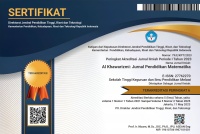PERSEPSI SISWA TERHADAP PENGGUNAAN KUIS DALAM PEMBELAJARAN METEMATIKA
DOI:
https://doi.org/10.46368/kjpm.v2i1.611Abstract
Abstract: The quiz motivation and learning outcomes of students, Based the result observations march 13,2020 at SMPN 6 Nanga Pinoh, consirended frighetenig to people student. Therefore student perceptions are needed. Aim know students perceptionsof quizzesin learning procces of mathemetics. This type of descriptive research ues a Cross Sectional Survey design (one tim-data collection). The research sample was students of class VIII B even semester of the academic year 2020 - 2021, a total of 21 students consisting of 12 male students and 9 female students. The research method a survey method, a qualitative approach. This type of descriptive research uses a Cross Sectional Survey design (one-time data collection). Perception questionnaire sheet instruments, assessment questionnaire sheets for quizzes, and teacher interview sheets. Non-test data collection techniques. Descriptive statistical data analysis used the calculation of mean or mean (M), median (Me), mode (Mo), and standard deviation (SD). The results showed responses to the questionnaire of students' perceptions at SMP Negeri 6 Nanga Pinoh of whit a 66,7% Very Positive and The results of questionnaire responses to the quiz questions were 90,5% Very Positive. The conclusion researching students' perceptions of quizzes is categorized as Very positive.
Keywords: Students' Perceptions of the Use of Quizzes.
Â
Abstrak: Kuis berpengaruh terhadap motivasi dan hasil belajar peserta didik. Berdasarkan hasil observasi 13 maret 2020 di SMPN 6 Nanga Pinoh. Kuis dianggap menakutkan bagi siswa maka persepsi siswa sangat diperlukan tujuan untuk mengetahui persepsi siswa terhadap penggunaan kuis dalam proses pembelajaran metematika. Jenis penelitian deskriptif menggunakan desain Cross Sectional Survey (pengumpulan data satu kali). Sampel penelitian siswa kelas VIII B semester genap tahun ajaran 2020 – 2021, Jumlah 21 siswa terdiri dari 12 siswa laki – laki dan 9 siswa perempuan. Metode penelitian adalah metode survey, pendekatan kualitatif. Instrumen lembar angket persepsi, lembar angket penilaian kuis, dan lembar wawancara guru. Teknik pengumpulan data non tes dengan analisis data statistik deskriptif menggunakan perhitungan mean atau rerata (M), median (Me), modus (Mo), dan standar deviasi (SD). Hasil penelitian menunjukan respon angket persepsi siswa di SMP Negeri 6 Nanga Pinoh dengan persentase 66,7% Sangat Positif dan hasil respon angket penilaian terhadap soal kuis dengan persentase 90,5% Sangat Positif. Kesimpulan dalam penelitian persepsi siswa terhadap penggunaan kuis dikategorikan Sangat positif.
Kata Kunci :Persepsi Siswa Terhadap Penggunaan KuisReferences
Arikunto, Suharmini. (2010 : 72-77). Prosedur Penelitian Suatu Pendekatan Praktik. Jakarta: Rineka Cipta.
Azwar, Saiuddin. (2007). Metode Penelitian. Yogyakarta: Pustaka Pelajar.
Gibson, dkk. (2010). Organisasi dan Menajemen Prilaku Edisi Empat. Jakarta: Erlangga
Supriyono, Widodo. (2008). Psikologi Belajar. Jakarta: PT Rineka
Thoha, M (2011). Prilaku Organisasi Konsep Dasar dan Aplikasinya. Jakarta : PT. Raja Grafindo Prasada.
Downloads
Published
How to Cite
Issue
Section
Citation Check
License
Authors who publish with this journal agree to the following terms:
1. Authors retain copyright and grant the journal right of first publication with the work simultaneously licensed under a Creative Commons Attribution License that allows others to share the work with an acknowledgement of the work's authorship and initial publication in this journal.
2. Authors are able to enter into separate, additional contractual arrangements for the non-exclusive distribution of the journal's published version of the work (e.g., post it to an institutional repository or publish it in a book), with an acknowledgement of its initial publication in this journal.
3. Authors are permitted and encouraged to post their work online (e.g., in institutional repositories or on their website) prior to and during the submission process, as it can lead to productive exchanges, as well as earlier and greater citation of published work.






